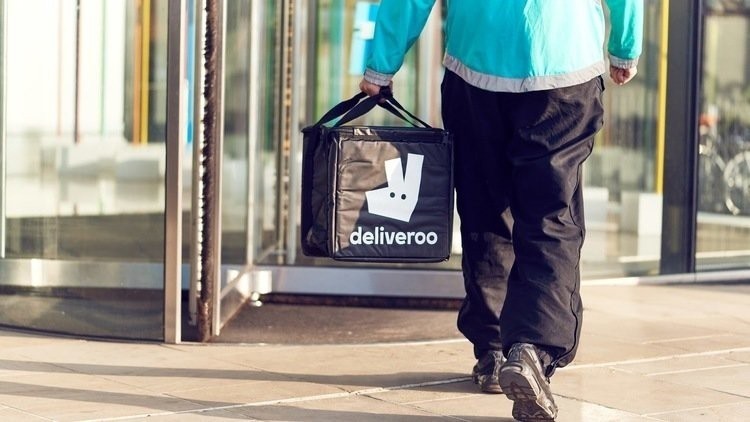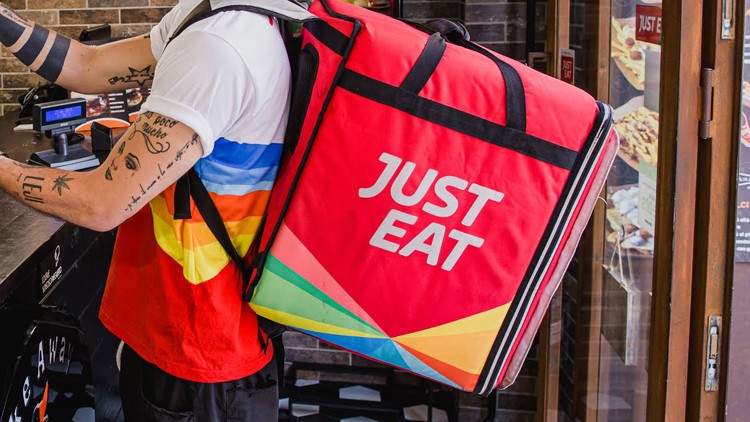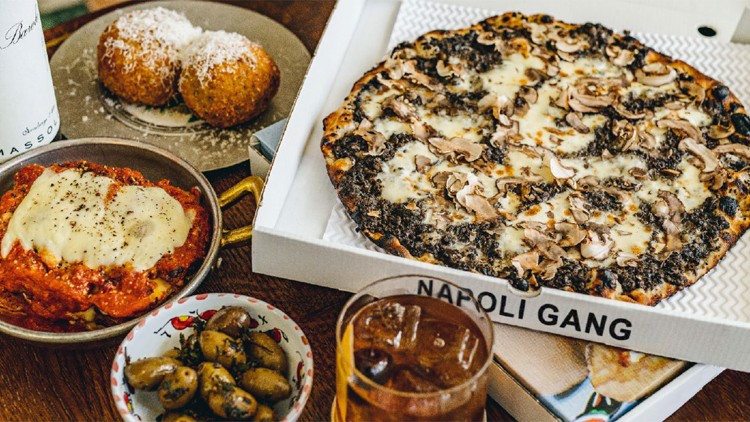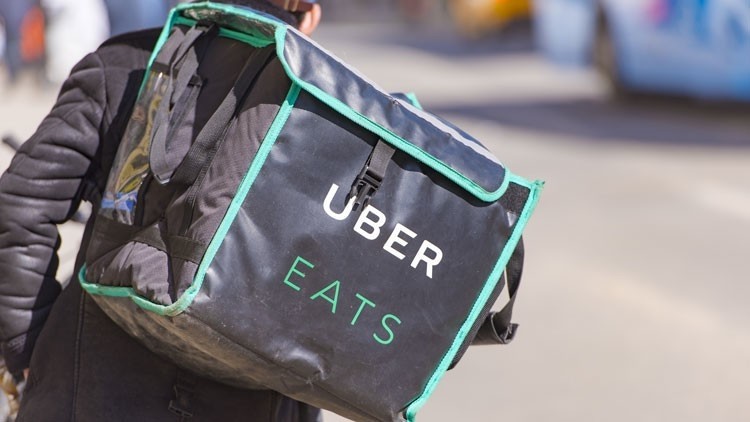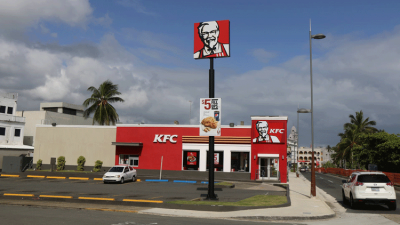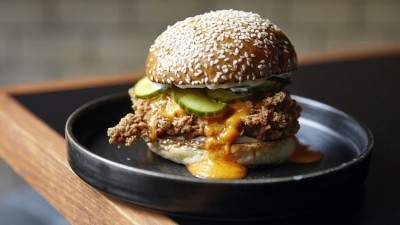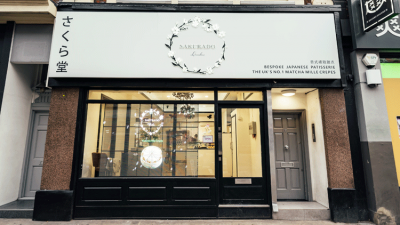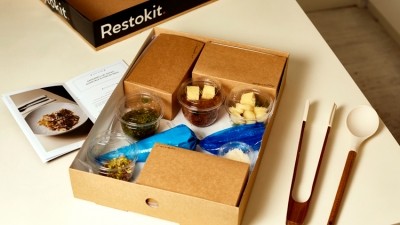sponsored by Deliverect
Delivering the goods: why 2020 is the year delivery came into its own
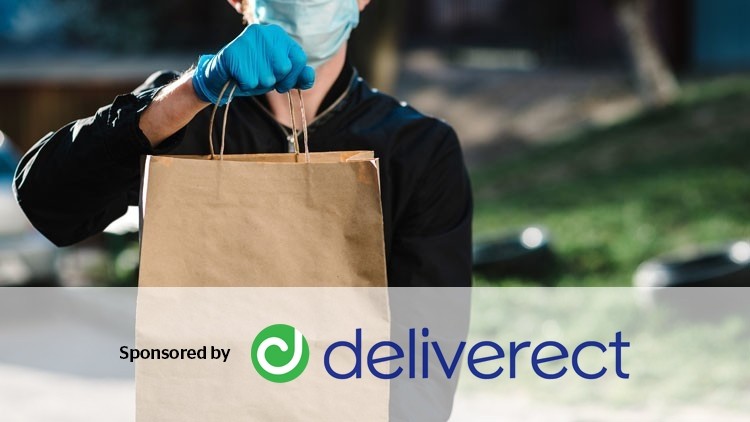
The Coronavirus lockdown looks to have forever changed the UK’s relationship with food delivery. With restaurants and other hospitality venues closed for eat-in for the best part of three months, consumers were desperate for someone else to cook their dinner - and businesses were even more desperate for their custom.
In fact, many operators entered the delivery space for the first time in a bid to keep on people’s radars, diversify revenue streams and keep at least some cash moving through the till. The hospitality industry switched things up and - perhaps unsurprisingly given the unprecedented nature of the situation - consumers did too.
“The way customers interacted with delivery changed completely,” says Just Eat head of strategic accounts Amy Heather. “They ordered more and they ordered at different times of the day. We found that lunch started at about 11am and that dinner started at 5pm. We also saw that people were ordering much earlier in the week.”
Perhaps one of the most enduring effects of the pandemic is that delivery is no longer viewed as a weekend treat with orders now spread more evenly across the week.
“There’s been a shift in consumer behaviour over the last six months and I think it’s going to stick,” says Sunny Chhina, the owner of The Fat Pizza franchise. “People just aren’t going out as much. And with curfew, we’re actually finding we’re getting fewer late-night orders.”
The delivery-focused business has been so busy that it’s yet to re-open its stores for customer collection, and it’s also looking to open 10 more locations before the year is out.
The delivery sector was already booming prior to the Coronavirus crisis. According to Statista’s Food Delivery and Takeaway Market Report, the market value of food service delivery increased from £8.1b to £8.5b between 2018 and 2019.
Online food orders were expected to show an annual growth rate of 6.5%, resulting in a projected market value of £5,974m by 2024. But the profound changes in the marketplace and shifts in customer behaviour is likely to accelerate this growth.
According to analyst CGA, 60% of 18-24 year olds say they’ve increased their use of food delivery services as a result of the pandemic and 26% say they’re planning to increase their use of delivery services.
“We have seen that demand for online food delivery has soared during the pandemic,” says a Deliveroo spokesperson. “Due to the popularity of ordering food online, we have had 11,500 new restaurant partners join Deliveroo since March, 8,800 of which are small and independent restaurants.”
To match the high demand, and ensure that customers are able to receive their orders, Deliveroo has more than doubled the number of riders it works with from 25,000 to more than 50,000 in the UK over the course of 2020.
Ordering trends
Lockdown has also had a dramatic and enduring impact on what consumers are ordering. Data complied by corporate catering and office food delivery service City Pantry and Just Eat found that plant-based orders have risen by almost a third (29%) across the nation while alcohol orders went up by more than a third (36%).
The average price of an order increased by 10% as people look to treat themselves, but a lot of people still had an eye out for a bargain with searches for takeaway discount codes up 23% during lockdown.
“With much of the country working from home over the last six months, we have seen a significant rise in demand for deliveries to homes,” says City Pantry financial director Tom Squire. “Convenience and variety play a big role in this increased demand, with busy remote workers not able to spend sufficient time preparing all their meals from scratch every day. We’ve seen that lockdown has encouraged people to use their lunch breaks to curate a better work-life balance, with healthier foods seeing increased orders.”
This last point is backed up by data from the same study - in the North East, for example, orders for healthy vegan and vegetarian food were up 125%.
Deliveroo observed an even more significant rise in demand for healthy products over the lockdown period with orders up 282%. The increase is driven by new partnerships with grocery, convenience shops and delis.
To respond to the demand for more healthy options on Deliveroo, the food delivery company has brought more health-focussed restaurants on to its platform. New launches on the platform with a healthy ethos include Kauai (Edinburgh), Foodwell (Manchester) and Atis (London).
Deliveroo has also formed partnerships with health and wellbeing concepts. In May, it launched its first permanent virtual CBD store with Trip, providing customers access to CBD oils and drinks on-demand. London’s TheDrug.Store also launched an exclusive partnership with Deliveroo to provide Londoners with a range of beauty and health products.
“Throughout 2020 Deliveroo has responded to the increased consumer interest and concern for wellbeing,” says Deliveroo’s global director of new businesses Tom Peters. “By launching partnerships with a broad range of grocery, restaurant and innovative food brands across the UK, we are able to give our customers the widest selection of healthy products as well as continuing to make them even more accessible.”
But it wasn’t all so virtuous. In April, Just Eat recorded a 36% jump in dessert orders with chocolate fudge cake, strawberry cheesecake and apple pie among the most popular items. Dessert focused-group Creams is a big beneficiary of bored households wanting to treat themselves to something sweet. In April, delivery sales increased by 48% and the volume of delivery orders increased by 125% when compared to the April prior. The bestselling items were milkshakes and waffles.
Finding new revenue streams
The pandemic has been particularly tough on businesses that have a heavy reliance on office workers. Coffee specialists and sandwich shops have been hit especially hard and are now having to pivot to stay relevant with much of the UK’s work force clocking in without leaving the house.
Delivery has been a useful tool for many because it provides flexibility and a way to utilise excess capacity. Coffee chain Caffè Nero entered the world of delivery for the first time earlier this year by way of an exclusive partnership with Uber Eats. Through the partnership, customers are able to order coffee, hot drinks and a selection of food to go via the Uber Eats App or website, delivered directly to their door.
“Since we’ve opened some of our stores for takeaway, we’ve seen strong demand for our coffee. We want to be able to help those unable to visit one of our open stores enjoy our coffee without compromising the premium quality. I believe the partnership with Uber Eats allows us to do that and continue to as we open more stores,” says Caffè Nero UK CEO Will Stratton-Morris.
The pandemic has also some very premium operators explore the delivery space. Le Deli Robuchon - part of the restaurant group founded by the late multi-Michelin-starred French chef - is working with partners including UberEats to offer its upscale products to customers within a 2.5 radius. The range includes sandwiches, quiches, salads and fine wines and is pitched primarily at affluent locals and office workers.
Glitzy Chinese restaurant chain Hakkasan and its sister dim sum brand Yauatcha have also entered the delivery fray. The project has been so successful that the delivery radius of its Mayfair restaurant has been extended to the affluent North London area of Hampstead. The brands are working with Deliveroo and Supper to deliver the likes of black truffle roast duck and grilled Chilean sea bass in honey.
Boxing clever
Another legacy of the pandemic will be restaurants looking beyond traditional hot food delivery to get their food into their customer’s homes. Venues of all shapes and sizes - from Michelin-starred temples to gastronomy through to the big chains - have embraced meal boxes and meal kits.
Some require a significant investment in time and a degree of culinary know-how, while others can simply be heated up. Because they don’t need to be delivered hot, such products have the potential to greatly simplify logistics.
The two Michelin-starred Kitchen Table has gone big on meal kits, offering a £75 per person 7-course menu and a 11-course menu that includes a bottle of grower Champagne priced at £125 per person. The monthly-changing menus are available across London for delivery on Fridays only.
Shoreditch barbecue restaurant SmokeStak has also introduced meal kits. The move follows the success of a stripped back takeaway offer introduced during in lockdown that saw customers able to come in and buy smoked meats by weight.
But barbecue aficionados can now order SmokeStak smoked meats and bun kits directly to their front door delivered via overnight courier. All meat is fully-smoked and cooked in-restaurant before being chilled and vacuum-packed for dispatch nationwide in thermally insulated recyclable box. Those seeking to fully recreate the Smokestak experience at home can download a playlist of the restaurant’s favourite tracks.
“We’ve been working hard to make sure our smoked meats, buns, slaws and sauces arrive exactly as we want them to, and we’re excited to bring our barbecue to the homes of as many people as we can,” says owner David Carter.
Dark forces
Delivery even allowed some operators to expand their operations during Lockdown. London-based Greek street food player The Athenian opened several dark kitchens during the pandemic in partnership with Deliveroo Editions.
“When the virus hit, we knew we wanted to keep the business running, both to help safeguard the jobs for our teams and as an avenue for allowing us to support and help feed the community,” says co-founder Neo Christodoulou. “And so, as well as keeping open what sites we could to offer delivery, we spoke to Deliveroo about potentially expanding our reach through other Editions kitchens.”
The Athenian has now opened dark kitchens in reading and Brighton, greatly extending its reach and opening up the possibility of full-service restaurants further down the line. Many other brands - including Shake Shack, Coqfighter and Baba G’s - are also opening dark kitchens, a key appeal being that during local in and even national lockdowns they will still be able to trade with demand likely to be high.
Doing the right thing
The huge reliance on couriers during the pandemic has made many customers think more about the ethics of food delivery. The employment practices of the big deliver players have never been under greater scrutiny and some restaurants are even putting in their own standards.
Big Mamma - the company behind London Italian restaurants Gloria and Circolo Popolare - has launched a pizza-focused delivery-only brand called Napoli Gang that seeks to make things more equitable for both its own staff and couriers. The irreverent, Paris-founded group is looking to improve conditions for delivery drivers by asking its exclusive delivery partner Uber Eats to sign an ethics code. Napoli Gang will also give 1% of each order value directly to the delivery driver.
According to Deliveroo, tipping doubled during the pandemic with customers keen to show their appreciation to riders. In response, the company has introduced post-rider tipping, so that customers can thank their rider directly.
Moving into delivery
Clearly there’s a lot of opportunity out there with delivery, but how can restaurant moving into the space ensure they get it right? Just Eat’s Amy Heather believes restaurants should initially just focus on the basics so as not to get overwhelmed.
“The first thing to look at is the menu, because that’s your store front,” she says. “Make sure your menu is properly tailored to delivery. You almost certainly want a separate menu for the delivery side of your business. It’s also important to listen to what your customers are saying. There are tangible insights you can get from reading your reviews.”
Uber Eats advises restaurants to make sure their dishes look the part. “Showing their dishes at their absolute best in-app, while remaining true to what is being offered to the customer is really important. Restaurants can also boost their offering by being able to offer drinks, starters and desserts to ensure they're a one-stop-shop for hungry customers,” says a spokesperson.
An understanding of what’s selling is enormously helpful when tuning a delivery offer. Deliverect, which works with restaurant brands including Absurd Bird, Dishoom and Tonkotsu, helps connects restaurants to third-party delivery platforms such as Just Eat, Deliveroo and Uber via their EPoS systems, with restaurants able to adjust their menus quickly in order to test new dishes or remove those that are underperforming.
Deliveroo says that restaurants should do everything they can to get their brand into people’s homes. “It needs to be the experience that people know and love,” advises a spokesperson. “Thankfully, technology is making it easier for restaurants to build a deeper understanding of their customers' needs.”
Deliveroo recently introduced a service called Brought to You by Deliveroo which allows customers to order directly from a restaurant’s own website. “Through this, restaurants can deepen their relationships with their most valued and loyal customers directly, as well as build new relationships through targeted marketing campaigns,” the spokesperson continues.
Speeding things up
All the effort that goes into getting the marketing and the cooking right will be for nothing if restaurants can’t work with their delivery partners to get food to customers promptly and in good condition.
Packaging must not be overlooked, a spokesperson for Uber Eats says. “It’s all about matching the right packaging with the right cuisine. Restaurants need to ensure that food doesn’t get soggy through condensation, but also ensure the dish isn’t too cold when it gets to the customer,” says a spokesperson. “If you are serving a dish that has sauces or add-ons, consider including them in separate packaging to avoid the food getting messy or soggy on the journey.”
Other things restaurants can do to speed up their delivery services include adjusting preparation times, and optimising the menu for delivery by removing complex meals which take a long time to prepare. Furthermore, working closely with couriers to create an efficient handoff process will also help to speed up the delivery services.
Choosing the right technology partners is essential and a wide range of solutions have appeared to help restaurants raise their delivery game. For example, Deliverect can reduce miss orders and streamline ordering by bringing orders from lots of fragmented channels together, allowing restaurants to easily work with multiple delivery partners.
“With online orders automatically pushed to the EPoS, there's no need to manually re-enter order receipts anymore, saving time and eliminating errors,” says a Deliverect spokesperson. “A subscription also comes with access to an easy-to-use multi-location menu builder, which allows restaurants to quickly update and publish their menus across the different delivery platforms.”
The Insider: Jerome Laredo, chief revenue officer, Deliverect
How has the pandemic changed the delivery sector?
We’ve seen a boom in the delivery business. Restaurants saw online delivery and online ordering as a nice-to-have feature. Due to COVID19, restaurant owners realised that being online is the way to survive during times that customers can’t dine-in. We’ve seen restaurants changing their approach, being inventive in terms of engaging customers through online channels by being online on multiple platforms, organising special offers, give-aways... . The delivery sector has become crucial for the survival of the hospitality industry.
What are the key things to consider when launching a delivery offer?
Make sure to select the right delivery providers and the suitable tech that will support your online sales business. In order to create a high-quality, consistent off-premises customer experience, you should look into the delivery tech solutions that are on the market today. Once you’ve defined those, it is important to carefully select the dishes you’ll be selling online. Setting up a separate menu for your online sales is key. Finally you need to make sure that people are aware they can order online by marketing your delivery service.
What are the key benefits of a omni-channel approach to delivery?
Today’s consumers want to order their food fast, wherever they are, whenever they feel like it. A seamless and connected customer experience is a must, not just a nice-to-have. For restaurants, that means providing multiple ways for your customers to order, pay, and get their meals - aka the omni-channel approach for restaurants. That’s why it’s crucial to integrate as many channels as possible into your restaurant’s point-of-sale system - and other business systems for personnel planning, inventory management, reporting, etc. By ensuring that your online delivery and takeout orders, and your kiosk and QR orders are flowing into your POS, you can provide an excellent experience while focusing on your core business: preparing and serving delicious food. Revenue was expected to show an annual growth rate (CAGR 2020-2024) of 6.5%, resulting in a projected market volume of £5,974m by 2024. Since COVID19, online food delivery has been adopted overnight and these projections will only increase. Established food brands will take over an omni-channel approach by establishing a deliberate online presence. Virtual brands will become an important part of the online food delivery market as well.
